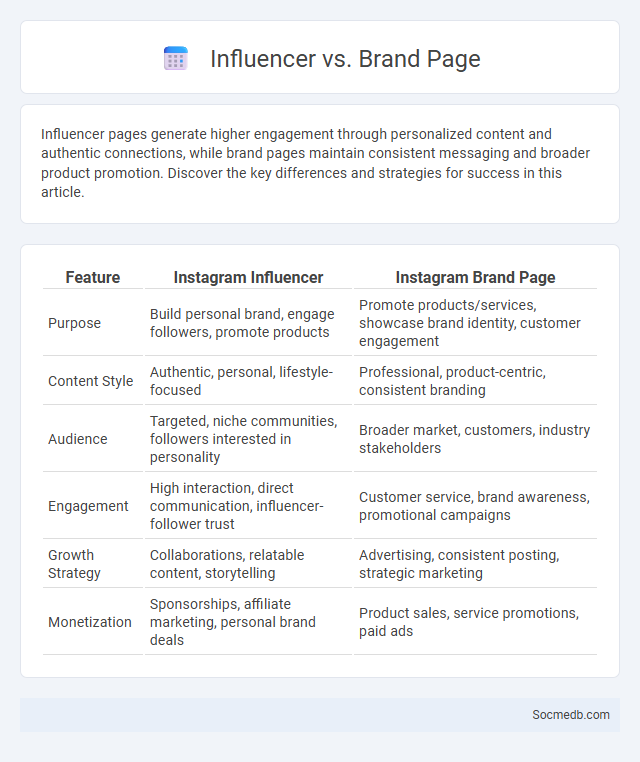
Photo illustration: Influencer vs Brand page
Influencer pages generate higher engagement through personalized content and authentic connections, while brand pages maintain consistent messaging and broader product promotion. Discover the key differences and strategies for success in this article.
Table of Comparison
| Feature | Instagram Influencer | Instagram Brand Page |
|---|---|---|
| Purpose | Build personal brand, engage followers, promote products | Promote products/services, showcase brand identity, customer engagement |
| Content Style | Authentic, personal, lifestyle-focused | Professional, product-centric, consistent branding |
| Audience | Targeted, niche communities, followers interested in personality | Broader market, customers, industry stakeholders |
| Engagement | High interaction, direct communication, influencer-follower trust | Customer service, brand awareness, promotional campaigns |
| Growth Strategy | Collaborations, relatable content, storytelling | Advertising, consistent posting, strategic marketing |
| Monetization | Sponsorships, affiliate marketing, personal brand deals | Product sales, service promotions, paid ads |
Introduction: Understanding Influencer, Brand Page, and Virality
Social media platforms empower influencers to shape trends and drive engagement through authentic content creation. Brand pages serve as strategic hubs for businesses to connect with target audiences, enhance brand visibility, and foster customer loyalty. Virality arises when compelling content rapidly spreads across networks, amplifying reach and generating exponential user interaction.
Defining Influencer Marketing: Strengths and Limitations
Influencer marketing leverages individuals with substantial social media followings to promote brands, products, or services, tapping into their authentic connections with target audiences. Strengths include enhanced brand credibility, increased engagement rates, and access to niche markets through personalized content. Limitations involve challenges in measuring ROI accurately, potential influencer misalignment with brand values, and risks of follower fraud or audience fatigue.
Brand Pages: Building Authority and Trust
Brand Pages on social media serve as pivotal platforms for establishing authority and building trust with target audiences. Consistently sharing valuable, transparent content and engaging with followers enhances credibility and fosters long-term customer loyalty. Optimizing these pages with authentic brand stories, customer testimonials, and industry expertise drives organic growth and improves search engine visibility.
The Concept of Virality in Digital Marketing
The concept of virality in digital marketing refers to the rapid and widespread sharing of content across social media platforms, generating exponential reach and engagement. Content with high virality leverages emotional appeal, relatable messaging, and shareability to encourage users to distribute it organically, boosting brand visibility without significant paid promotion. Marketers analyze engagement metrics and social sharing patterns to optimize campaigns for virality, increasing conversion rates and enhancing overall digital marketing ROI.
Audience Engagement: Influencer vs Brand Pages
Audience engagement on social media varies significantly between influencer and brand pages, with influencers often fostering more authentic interactions due to their personal connection with followers. Influencers typically achieve higher engagement rates by leveraging trust and relatability, while brand pages rely on strategic content and advertising to maintain audience interest. Your social media strategy should balance the strengths of influencer collaboration and brand-driven content to maximize engagement and reach.
Content Strategy: What Drives Virality?
Effective content strategy for social media virality centers on creating emotionally resonant and highly shareable posts that tap into current trends and cultural moments. Leveraging user-generated content, striking visual storytelling, and timely relevance increases engagement rates and organic reach. Data-driven insights on audience behavior and platform algorithms further optimize content distribution to maximize viral potential.
Authenticity and Credibility: Who Wins the Trust?
Authenticity and credibility are crucial factors that determine trustworthiness on social media platforms such as Instagram, Twitter, and LinkedIn. Verified accounts, transparent communication, and consistent content help influencers and brands establish a genuine connection with their audience. Algorithms prioritize authentic engagement, meaning users tend to trust profiles that demonstrate honesty and reliability in their interactions and shared information.
Cost and ROI: Comparing Influencer Campaigns and Brand Efforts
Measuring the cost and ROI of social media campaigns reveals that influencer partnerships often deliver higher engagement rates for your budget compared to traditional brand efforts. Influencer campaigns typically require lower upfront investment yet drive targeted audience reach and authentic content, increasing conversion potential. Brands focusing on organic social media strategies may save costs but often face slower ROI growth due to limited scalability and less personalized consumer connection.
Case Studies: Viral Success Stories Across Platforms
Case studies of viral success stories across social media platforms reveal the power of authentic content and strategic timing in capturing audience attention. Brands like Wendy's on Twitter and TikTok creators such as Charli D'Amelio exemplify how engagement drives exponential growth and brand loyalty. Your campaigns can harness these insights by analyzing viral elements to replicate successful engagement strategies.
Choosing the Right Approach: Influencer, Brand Page, or Virality?
Selecting the right social media strategy depends on your business goals, target audience, and content type. Partnering with influencers leverages their established trust and reach to boost brand credibility and engagement. Creating a dedicated brand page fosters direct customer relationships, while striving for virality requires highly shareable, emotionally resonant content that sparks widespread user interaction.
 socmedb.com
socmedb.com